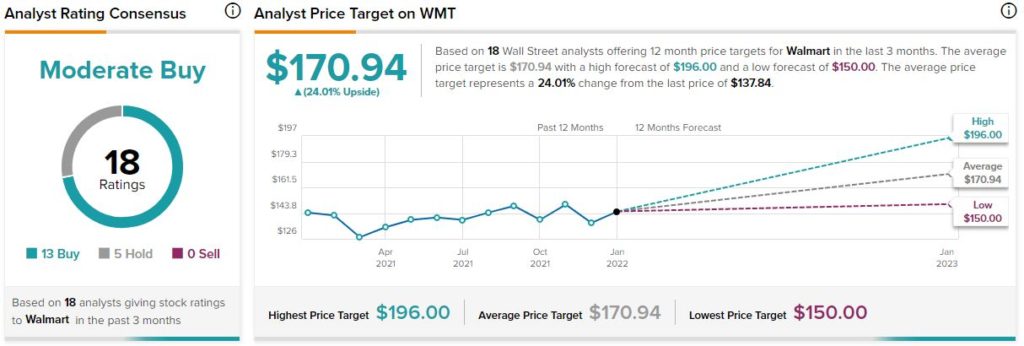One of the most iconic retail titans in the market, Walmart (WMT), is generally perceived to be among the safest and most defensive retailers. Over many decades this has proven to be true.
Claim 50% Off TipRanks Premium and Invest with Confidence
- Unlock hedge-fund level data and powerful investing tools designed to help you make smarter, sharper decisions
- Stay ahead of the market with the latest news and analysis so your portfolio is always positioned for maximum potential
However, the rise of competition in the e-commerce space, led by Amazon, has shifted investors’ focus toward where the future of retail is long-term. Digital retail has become the retail most investors are concerned with right now.
As mainly a physical bricks-and-mortar retailer, Walmart has had a lot of catching up to do, which is what it’s been doing. Walmart has stepped up to the plate and hit some big home runs in the e-commerce race. The company’s online sales are surging, a testament to Walmart’s brand and strategy of offering everyday low prices.
Can this continue? Time will tell. However, I’m bullish on Walmart’s long-term ability to compete in this space.
Margin Declines Short-Term in Nature
Historically speaking, Walmart’s margins have been a big focal point for investors. Walmart’s ability to generate a rather impressive dividend yield of 1.6% (all things considered) is reliant on strong and preferably growing margins.
However, Walmart’s margins took a hit this past year. Supply chain concerns and a lower-margin mix of products being sold led to this decline. The question is whether these margin concerns are short-term in nature or represent something longer-term.
There are certainly a growing group of investors who may believe that these margin pressures will continue over the long term. Some indicate that inflation is a runaway train right now, and there’s no stopping inflationary forces on margins right now.
Additionally, e-commerce sales typically have lower margins. Since these make up a higher percentage of Walmart’s overall revenue, this retailer will struggle to keep up with its historical fundamentals.
On the other hand, there are many who believe that Walmart has the capabilities to keep inflation under control. Yes, e-commerce is becoming an increasingly important part of Walmart’s business. However, the company is learning how to incorporate this business in a profitable way.
Walmart’s margins are ultimately within the company’s span of control. There’s no doubt that near-term pressures are likely to remain. However, Walmart is a company that’s found a way to traverse decades of trials and tribulations to get where it is.
This retailer has found innovative methods to increase its margins and keep prices low for its core blue-collar consumer base. Owning its own stores and integrating an omnichannel approach are just two of the incredibly simple yet powerful drivers of Walmart’s core business right now.
Continued investment in offline operations is likely to be one key driver of e-commerce margin expansion. As the company is able to leverage its existing footprint to bring shipping costs down, investors stand to benefit. Thus, Walmart may be viewed as a truly integrated real estate play, with physical and digital retail operations built on top of this impressive real estate base.
E-Commerce Growth Has Proven to Be Important for Walmart
Despite concerns around margins, Walmart’s e-commerce business has been central to the investment thesis for this stock for some time. Indeed, compared to other big-box department stores such as Macy’s (M), Walmart performed better in terms of handling the e-commerce driven pandemic environment. Many point to the fact that Walmart’s e-commerce growth rate actually exceeded that of Amazon, an impressive feat during this time.
Much of this growth has to do with Walmart’s attempt to capture market share in emerging markets. The retailer has targeted fast-growing economies such as India and China for growth. Indeed, Walmart’s move to outbid Amazon for Flipkart suggests this retailer is all-in on this trend.
Of the markets many investors are bullish on for long-term growth, India is certainly a space worth considering. Often overlooked by many international retailers, India’s population growth, and particularly the growth of this country’s middle class, is remarkable. Top retailers like Walmart that are looking to emerging markets for growth are leveraging their brands and expertise within these countries to hit the ground running.
Overall, there’s a lot to like about Walmart’s e-commerce growth strategy.
Wall Street’s Take
Turning to Wall Street, Walmart has Moderate Buy consensus rating. Out of 18 analyst ratings, there are 13 Buy recommendations and five Hold recommendations.
The average Walmart price target of $170.94 implies 24% upside potential. Analyst price targets range from a high of $196 per share to a low of $150 per share.

Bottom Line
As the e-commerce space continues to evolve, Walmart is a key player that investors shouldn’t ignore. This company’s focus on truly becoming an e-commerce juggernaut is notable, and Walmart is making some strong strides in this area.
Of note, many believe Walmart will not only be able to accomplish its goal of picking up e-commerce market share but doing so profitably over the long term. The company’s growth trajectory is impressive for a mega-cap retailer and looks likely to continue over time.
Overall, WMT stock is one that deserves a look from long-term investors as a solid buy-and-hold for decades to come. This company’s track record suggests that this retailer isn’t done growing any time soon.
Download the TipRanks mobile app now
To find good ideas for stocks trading at attractive valuations, visit TipRanks’ Best Stocks to Buy, a newly launched tool that unites all of TipRanks’ equity insights.
Read full Disclaimer & Disclosure
















